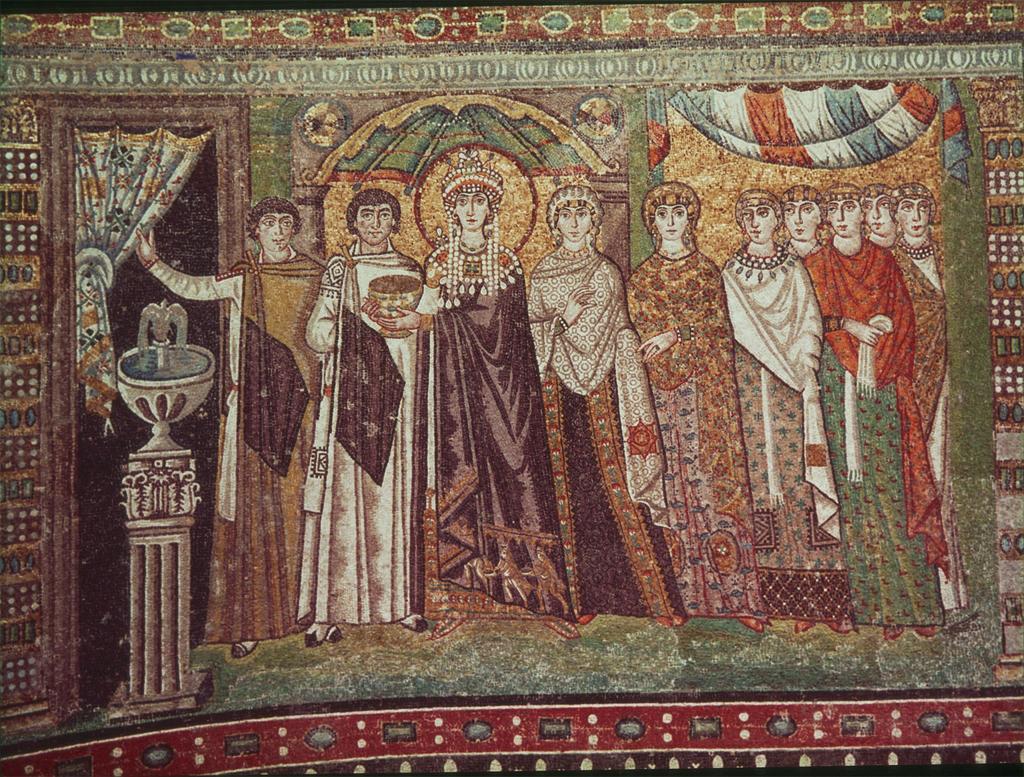On 12 November 1028 Byzantine Empress Zoë took the imperial throne – for the first time – as empress consort to Romanos III argyros. Zoë Porphyrogenita (978 –1050) also reigned alongside her sister Theodora from April to June 1042. She was enthroned as the Empress Consort to a series of co-rulers beginning with Romanos III in 1028 until her death in 1050 while married to Constantine IX.
Zoë was one of the few Byzantine empresses who was Porphyrogenita, or “born into the purple” (that is, she was born to a reigning emperor). She was the second daughter of Constantine VIII and Helena, daughter of Alypius. Zoë lived a life of virtual obscurity in the imperial gynaeceum until circumstances (her dying father not having any sons) forced her into the centre of imperial politics.
In 1033, Zoë became enamoured of her courtier Michael, flaunted her lover openly, and spoke about making him emperor. Hearing the rumours, Romanos was concerned and confronted Michael, but he denied the accusations. On April 11, 1034, Romanos III was found dead in his bath, and there was speculation that Zoë and Michael had conspired to have him poisoned, then strangled or drowned. Zoë married Michael later the same day, and he reigned as Michael IV until his death in 1041. Key members of the court decided that Zoë needed a co-ruler, and that it should be her sister Theodora. A delegation headed by the Patrician Constantine Cabasilas went to the monastery at Petrion to convince Theodora to become co-empress alongside her sister. At an assembly at Hagia Sophia, the people escorted a furious Theodora from Petrion and proclaimed her empress along with Zoë.
Until her death in 1050, she enjoyed various amusements, and her rooms in the palace were filled with boiling pots and pans for the manufacture of ointments and perfumes. She had installed a laboratory (myrepseion) in her private quarters, where she prepared various cosmetics. All historical sources agree that she spent much of her time preparing not only perfumes but also drugs and poisons. Her laboratory was very well organized and the fires were burning day and night, while her female servants were helping her at the creation of new fragrances using imported essences from India and Egypt.
Reference: Panas, M., Poulakou-Rebelakou, E., Kalfakis, N. and Vassilopoulos, D. (2012), The Byzantine Empress Zoe Porphyrogenita and the quest for eternal youth. Journal of Cosmetic Dermatology, 11: 245–248. doi:10.1111/j.1473-2165.2012.00629.x
Christ Pantocrator Enthroned between Emperor Constantine IX Monomachos and the Empress Zoe; detail of Zoe. Mosaic, 1028-42 (c. 1030; the head of Constantine was substituted for that of Zoe’s first husband, Romanos, c. 1042). Hagia Sophia, Istanbul, Turkey. Photos: Erich Lessing/ART RESOURCE, N.Y. and Shmuel Magal, Sites and Photos.
Theodora and Her Court, c. 526-48. S. Vitale, Ravenna (Italy). Photo: University of California, San Diego.
Personification of Ktisis (Foundation) as a Byzantine Empress. Mosaic, marble, glass, c. 550. This monumental bust of a richly bejeweled lady who wears large pearls in her ears, a necklace of delicate stones about her throat, and two brooches-one clasping her yellow mantle and another at the tie of her dress-is an example of the exceptional mosaics created throughout the Early Byzantine world in the first half of the sixth century. Both her elaborate diadem and the neckline of her dress are bordered with alternating black and white tesserae meant to suggest pearls. The addition of blue glass to represent sapphires, or “hyacinths,” among the red and green glass gemstones on the mosaic is characteristic of sixth-century Byzantine taste. The modeling of the lady’s face with small olive-green and beige tesserae highlighted in white and shades of pink and the slightly asymmetrical arrangement of her large, softly staring eyes are typical of Byzantine painting of the period, which survives in the form of icons. Women with similar faces, hairstyles, necklaces, and pearl-bordered diadems carry martyrs’ crowns in the early-sixth-century mosaics in the nave at Sant’Apollinare Nuovo in Ravenna. A mosaic image of the archangel Michael, dated to 549, and in the Church of Sant’Apollinare in Classe, near Ravenna, has the same hair and eyes, as does the mid-sixth-century bust of the “Lady of Rank,” thought to be from Constantinople, also in the Museum (The Cloisters Collection, 66.25).
The rod that she holds, the measuring tool for the Roman foot, identifies her as a personification of the abstract concept of “Ktisis,” or Foundation, and symbolizes the donation, or foundation, of a building. Personifications of abstract ideas, as developed by the Stoic philosophers, remained popular in the Early Christian era. Images of Ktisis inscribed with her name, and often showing her holding the same measure, survive on the floor mosaics of bathhouses as well as churches throughout the Byzantine Empire, from Antioch and Cyprus to such African sites as Qasr-el-Lebia and Ras-el-Hilal. The Metropolitan Museum of Art Collection, Nr. MMA_.1998.69.
Balance Weight formed as the Bust of a Byzantine Empress, c. 390-400. Among the most striking Byzantine weights to have survived are the imperial weights issued in the late 4th and 5th centuries. Typically they depict the same royal figures seen on coins to promote the legitimacy and stability of the state and to guarantee their validity as “honest weights.” Used on balance scales, the weights were sometimes filled with lead to make them heavier. The Cleveland Museum of Art, Nr. 1967.28.
Further Reading: Barbara Hill. Imperial Women in Byzantium 1025-1204: Power, Patronage and Ideology. New York: Pearson, 1999.
Lars Brownworth. Lost to the West: The Forgotten Byzantine Empire That Rescued Western Civilization. New York: Broadway Books, 2010.





